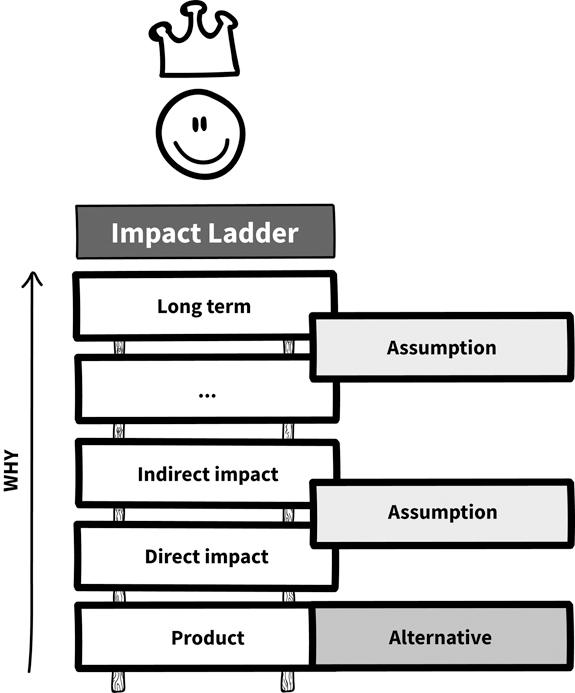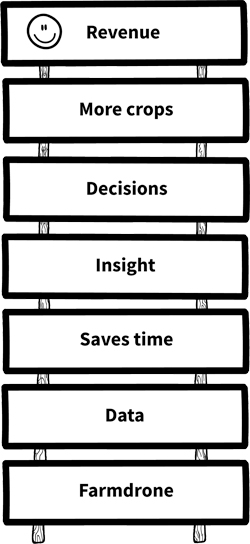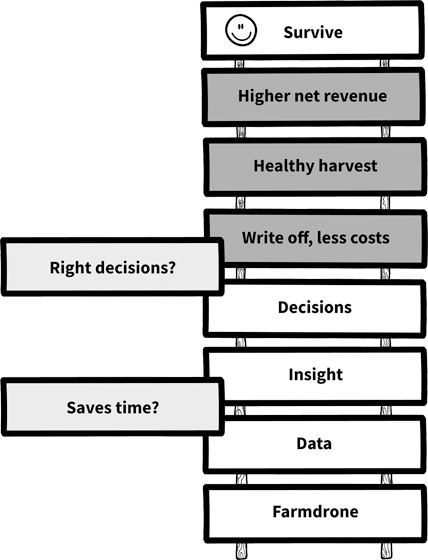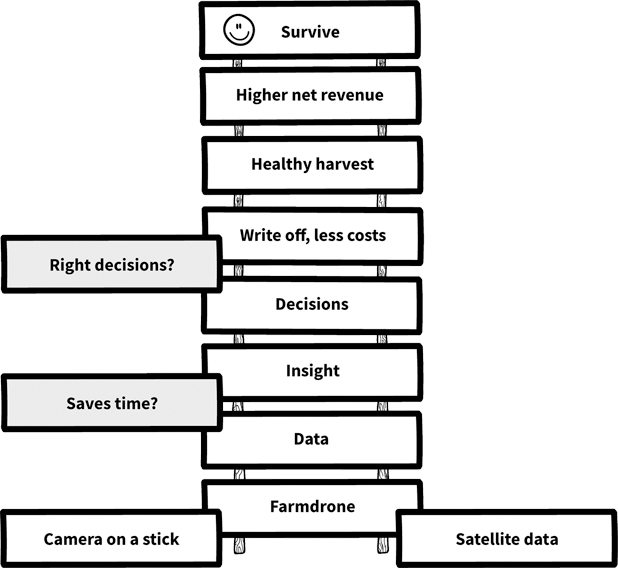1.3 How to Visualize the Customer Impact?
I would define Amazon by our big ideas, which are [customer-centric], putting the customer at the center of everything we do.

Introduction Questions
1. What makes the customers of your company more successful?
2. In which way is making the customers more successful a motivation for your teams and department?

Complex Customer Impact
In real life, it can be difficult to clearly understand the customer impact, especially when the customer is another company. Many teams think that they know the customer impact because they don’t know what they don’t know. To give these teams the right goals and to give them a proper KVI, it must be clear how the product delivers value to the customer. Successful agile leaders make sure that the agile teams really understand how they are beneficial for the customer.
For that, I’ve developed the Impact Ladder tool, which visualizes the customer impact and the assumptions accordingly. The Impact Ladder is partly based on the Five Whys technique.4
4. Serrat, O. 2017. The Five Whys Technique. In Knowledge Solutions. Springer, Singapore.
Tool 2: Impact Ladder
The Impact Ladder is a tool to make very clear how a product or service contributes to a positive impact for the customer. The Impact Ladder supports brainstorming and provides insight into the most important assumptions. The tool can be used for new and existing products and services. The Impact Ladder also makes it easier to switch between different types of users and target groups.
The Impact Ladder consists of three parts:
Impact levels
Assumptions
Alternatives
Schematically, the Impact Ladder looks like Figure 1.6.

Figure 1.6 Impact Ladder
Impact Levels
The impact levels show step by step how a product or service contributes to the success of the customer. The direct impact starts with the use: convenience, reliability, and time savings. A few levels higher is often cheaper or better. And another few levels higher, the strategic advantage and long-term results can be found.
Assumption
If the impact levels have been added to the Impact Ladder, the assumptions can be displayed. Figure 1.6 visualizes that an assumption is always between two consecutive impact levels. Examples are whether the product actually saves time or whether the costs are actually reduced. These assumptions are actually risks, often called business risks, and must be properly monitored during the development of the product. Changes, innovations, and experiments should be monitored to validate the assumptions.
Alternatives
Finally, there are alternative ways of delivering impact because there are often several ways to realize the same customer impact. This is visualized in the Impact Ladder by hanging alternatives next to the relevant impact level.
If there are two or more completely different branches in customer groups, not just one Impact Ladder can be made for this. In that case, a separate Impact Ladder works better for each branch. If, for example, the drone is also used for other industries, like road maintenance or life guards, each target group has a different Impact Ladder.
There are more examples of the Impact ladder on www.tval.nl.
Summary of Part 1—Co-Create Goals

This first part of the steering wheel explained how the agile leader can co-create goals. See the figure above for an overview of this part of the toolkit. Agile teams operate in a complex environment. Markets, technologies, competitors, and customers’ wishes change so quickly and so unpredictably that teams need a new type of goals to give them direction. In static or slow-changing markets, the performance of employees and teams can be measured relatively easily by measuring the output. An employee or team that produces more has a higher performance than others. But agile teams are different. Delivering more functionality in the app or handling more phone calls doesn’t necessarily make them more productive. Therefore, they need a different set of goals to measure their performance and give them direction. These new goals make it tangible and concrete what “winning the game” means. These goals, therefore, indicate when teams are really successful.
Agile teams need a clear and inspiring goal regarding what they need to achieve. This focuses on the overall objective and gives them the ability to change plans when unexpected things happen. For example, it is unknown in advance what the competition will do, how new technologies can be used optimally, and what the dynamics in teams will be. In order to find solutions, to embrace opportunities, and to seek synergy as a team, teams need goals for what they need to achieve. The focus is external; it should be on increasing the customer impact and thus the value for the company.
In Part 1, two practical tools were explained: the key value indicator (KVI) and the Impact Ladder. The KVI is the most important indicator for the team to find out whether they are generating value. The tool is expressed in a single number, visualized in a trend line, making the relationship between customer impact and value for the company tangible. The focus is on serving customers smarter and better, so that customers generate more value for the company—achieving more by doing less.
The Impact Ladder visualizes how products and services contribute to a positive customer impact: the tool makes the difficult and complicated customer’s situation clear.
The other three parts of the steering wheel reinforce this co-creating goals part. Part 2, “Facilitate Ownership,” will offer further practicality on how the teams can become proactive, proud, and energized. In Part 3, “Learn Faster,” we’ll discover that tools like T2L are crucial if the teams are looking at recent data. Part 4, “Design Healthy Habits,” gives the goals a healthy atmosphere and culture.
The Agile Leader as a Co-Creator of Inspiring Goals
In complex and quickly changing markets, it’s hard to know the perfect goal. Co-creating the goal with the teams serves the agile leader in three ways. First, the goal will probably be better because more people put thought into it. Second, the teams will know the “why” behind the goal, and if the goal needs to be changed or improved, the teams will come up with proposals and ideas. Last but not least, the teams will likely be more inspired to work on a goal they co-created than on a goal that is bestowed upon them. When searching for solutions, implementing improvements, and exceeding customer expectations, we expect a lot from the agile teams. It often takes a lot of energy and perseverance to grow as a team and achieve the goals. It is no longer about carrying out daily activities from 9 to 5, but rather about looking for solutions creatively. And, if these solutions initially do not work, it is about continuing to solve issues as a team. That is why it is important that the agile leader gets better and better in his role as a co-creator. That she asks for feedback in her motivational skills, she learns, and she grows. Finding and improving the inspirational environment for the teams is a discovery. Sketching a first version of the tools and learning as we go is the only way to continuously improve the tools and environment.
Knowing whether the teams have an inspiring goal, the following five Is can be used to gather feedback.
Influence. Do the teams feel that they can influence the metric?
Insight. Is the goal tangible and visual? Do team members update the metrics themselves and are they eager to know the latest numbers?
Ideas. Does it cause ideas to thrive? It should stimulate out-of-the-box thinking. Teams can have a list of ideas, innovations, and disruptive features to improve.
Intent. Is the intent behind the goal also clear? Can the team members explain the purpose or mission behind what they want to achieve?
Impact. Does it focus on the customer?
Concrete Actions
The following are some examples of actions to put the tools, examples, and ideas from Part 1 into practice.
Share ambitions and dreams more often—both your own and those of others. Practice and grow in inspiring and sharing each other’s passions.
Ask for examples of successful customers. Did agile teams deliver concrete customer impact in recent times? If so, share. If not, work together to find ideas about how to improve.
Make an overview of the teams and their KVIs. This makes it known which teams have a concrete KVI and which teams still need help with this.
Notes
_________________________________________________________________
_________________________________________________________________
_________________________________________________________________
_________________________________________________________________
_________________________________________________________________
_________________________________________________________________
_________________________________________________________________
_________________________________________________________________
_________________________________________________________________
_________________________________________________________________
_________________________________________________________________
_________________________________________________________________
_________________________________________________________________
_________________________________________________________________
_________________________________________________________________
_________________________________________________________________
_________________________________________________________________
_________________________________________________________________
_________________________________________________________________
_________________________________________________________________
_________________________________________________________________
_________________________________________________________________
_________________________________________________________________
_________________________________________________________________
_________________________________________________________________
_________________________________________________________________
_________________________________________________________________
_________________________________________________________________
_________________________________________________________________
_________________________________________________________________
_________________________________________________________________
_________________________________________________________________
_________________________________________________________________
_________________________________________________________________
_________________________________________________________________
_________________________________________________________________
_________________________________________________________________
_________________________________________________________________
_________________________________________________________________
_________________________________________________________________



